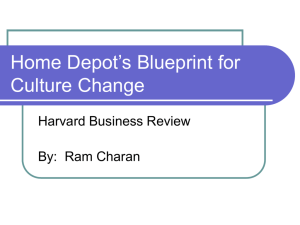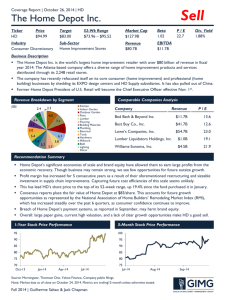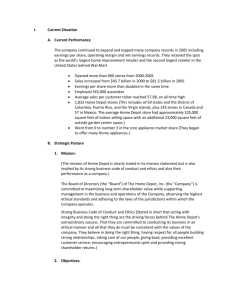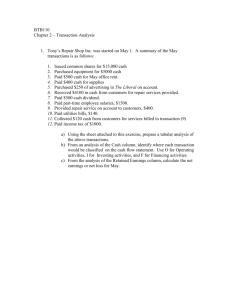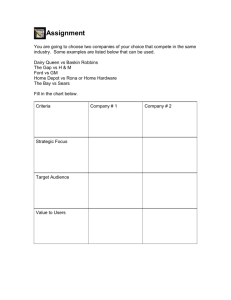EM-TRADE 2 - Spring 2004
advertisement
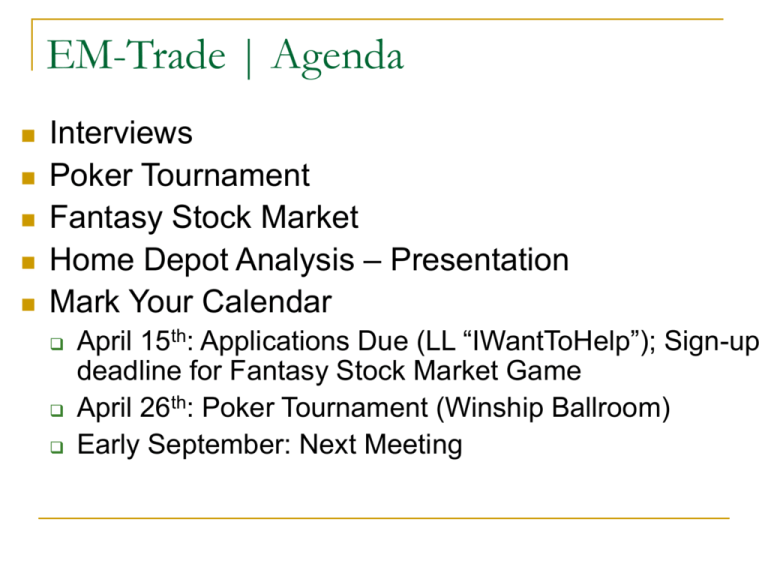
EM-Trade | Agenda Interviews Poker Tournament Fantasy Stock Market Home Depot Analysis – Presentation Mark Your Calendar April 15th: Applications Due (LL “IWantToHelp”); Sign-up deadline for Fantasy Stock Market Game April 26th: Poker Tournament (Winship Ballroom) Early September: Next Meeting Home Depot | Description The Home Depot owns and operates 1,471 do-ityourself warehouse retail stores offering building materials, home improvement products and related furnishings. For the FY ended 1/30/05, revenues rose 13% to $73.09B. Net income rose 16% to $5B. Revenues reflect increased sales due to the opening of new stores. Net income also reflect improved gross profit margins due to lower cost of merchandise sold as a percentage of revenue. Home Depot | Current Ratio Definition: Current Assets / Current Liabilities Current is short-term Current Assets: Money, Inventory Current Liabilities: Short-term debts Debts are IOUs General idea: A company is generally considered financially healthy when current assets are equal or higher than current liabilities. What to look for: Current Assets > Current Liabilities Home Depot’s Balance Sheet [Diagram] Recommendation: A current ratio of 2. Good (1.395) Home Depot | Debt/Equity Ratio Definition: Long-Term Debt / Equity Long-Term Debt Equity: Total assets – Total Liabilities General idea: A higher debt/equity ratio generally means that a company has been aggressive in financing its growth with debt. What to look for: A low Debt/Equity Ratio. The lower the ratio, the better. Home Depot’s Balance Sheet [Diagram] Home Depot: Long term debt / Equity = Ratio Year 2004 856,000 / 22,407 = 0.038 Recommendation: Ratio of 0.1. Great (0.038) Home Depot | P/E Ratio Definition: Price / Earning The price of the stock / the year earnings of a company. Earnings: Earning in EPS (Earnings per share) General Idea: The higher the P/E ratio, the higher the speculation of the company’s future earning performance What to look for: Depends. Optimistic: High P/E ratio. Conservative: Low P/E ratio Home’s Depot Income Statement - Look at EPS Home Depot’s Quote Ratio: 17.09 Recommendation: P/E ratio of 15. Great (17.09) Home Depot | Growth Rates Definition: The compounded annualized rate of growth of a profit, earnings, revenues, etc. Relative measurement (percentage): (This year’s profit – Last year’s profit) / (Last year’s profit) General Idea: Higher the growth rate, higher the risk. Want to look for growth. What to look for: Depends. Risk taker vs. Risk averse Home’s Depot Income Statement Revenue Growth: (64,816.0 - 58,247.0) / (58,247. 0 ) = 11% Recommendation: 10 to 15% growth rates. Great (11%) Home Depot | Earnings Earnings: The net income of a company during a specific period. Generally, but not necessarily, referring to after-tax income. Earnings are perhaps the single most studied number in a company's financial statements. They show how profitable a company is. Guidance has a role in the market because it provides information that can be used by investors to analyze the company, evaluate management, and create forecasts. Earnings Estimate: An analyst's estimate for a company's future quarterly or annual earnings. Analysts use forecasting models, management guidance, and fundamental information on the company in order to derive an estimate. Earnings Surprise: When the earnings reported in a company's quarterly or annual report are above or below analysts' earnings estimates. Companies are foolish if they think that they can alter the market's short-term focus. The Street will still do what it wants, and it will stay focused on quarterly timelines. If, however, more companies opt for no guidance, the Street may inadvertently become more rational and stop whipsawing stock prices for miniscule variances. When a positive earnings surprise occurs, share price will usually increase. A negative earnings surprise will usually result in a decline in share price. Earnings Growth Rate: indicators that reflect the opinions of industry analysts as to the growth potential of a company's earnings. The data is supplied by an outside service. Home Depot | Insider Trading Insider Trading: The buying or selling of a security by someone who has access to material, nonpublic information about the security. Insider trading can be illegal or legal depending on when the insider makes the trade: Illegal when the material information is still nonpublic. Trading while having special knowledge is unfair to other investors who don't have access to such knowledge. Includes: tipping others when you have any sort of nonpublic information. Directors are not the only ones who have the potential to be convicted of insider trading. People such as brokers and even family members can be guilty. Legal once the material information has been made public, at which time the insider has no direct advantage over other investors. The SEC, however, still requires all insiders to report all their transactions. Insider Trading (Prev. 6 months) Net Insider Trades -6.00 % Shares Owned # Buy Transactions 1.00 # of Institutions # Sell Transactions 7.00 Total Shares Held (Mil) Net Shares Purchased (Mil) Institutional Ownership -0.251 63.682 2,436.00 1,398.434 3 Mo. Net Purchases (Mil) 114.851 160.765 # Shares Purchased (Mil) 0.005 3 Mo. Shares Purchased (Mil) # Shares Sold (Mil) 0.256 3 Mo. Shares Sold (Mil) 45.913 An executive, director or major shareholder sold a small number of shares recently. (Neutral) Shares are neither being accumulated heavily nor sold heavily by financial institutions. (Neutral for a large company) Competitive Factors Price Store location Customer service Depth of merchandise Home Depot vs. Lowe’s 55% of Lowe’s are within 5 miles of HD HD commonly faces decline up to 15% when Lowe’s enters nearby Industry saturated in 4 years? Home Depot | Chart Analysis Price Volume Moving Averages MACD RSI Stochastic Price Volume The number of trades in a security over a period of time. Volume Volume Volume Moving Averages (MA) An average of data for a certain number of time periods. MACD (Moving Average Convergence/Divergence) -Displays trend following characteristics -Compares moving averages RSI (Relative Strength Index) - Compares overbought (>70) and oversold (<30) Stochastic Oscillator - A momentum indicator that measures the price relative to the high/low range over a set period of time. Thank You!

